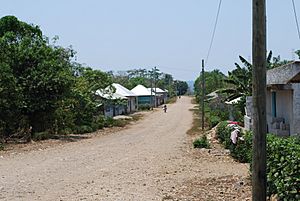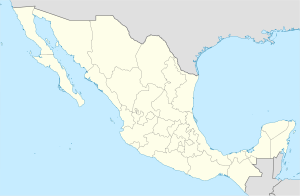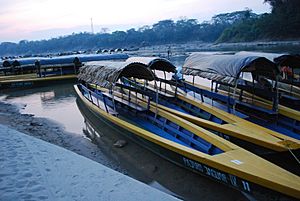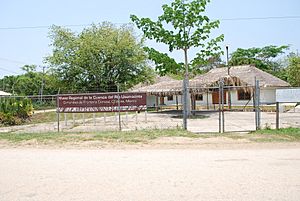Frontera Corozal, Chiapas facts for kids
Quick facts for kids
Frontera Corozal
|
|||
|---|---|---|---|

Residential street in the town
|
|||
| Country | |||
| State | Chiapas | ||
| Municipality | Ocosingo | ||
| Population
(2010)
|
|||
| • Total | 5,184 | ||
|
|||
Frontera Corozal is a town in the Mexican state of Chiapas. It sits right on the Usumacinta River, which forms the border with Guatemala. Most people living here are from the Ch’ol group.
The town was started in the 1970s by families who moved from northern Chiapas. Frontera Corozal is famous for its docks. From here, small boats called lanchas take people to the amazing ancient Yaxchilan Mayan ruins. You can also cross the river to Bethel, Guatemala.
Frontera Corozal also has a local museum. It shows off two large stone carvings called steles that were found nearby. The town is deep inside the Lacandon Jungle, surrounded by thick tropical rainforest. Sadly, this forest has been damaged over time. But don't worry, people are now working hard to protect the environment, especially on lands owned by the community. In 2010, about 5,184 people lived in Frontera Corozal.
Contents
About Frontera Corozal
Frontera Corozal is a town in the Ocosingo area of northeast Chiapas. It's a border town, located on the Usumacinta River right across from Bethel, Guatemala. The town began in 1976. Most of the first families were Ch’ol migrants. A few Lacandon and Tzeltal families also joined them. People from different groups usually get along well here.
The town and its nearby areas have nine neighborhoods. About 11,000 people live there. Most of the shops and services are in the town center, close to the river. The town has a fun "Festival of Corn" (Fiesta del Elote) every August. In May, they hold a special ceremony at the Tsolkinse caverns to ask for rain.
Frontera Corozal is connected by roads to Lacanja Chansayab, Chancalá, and Palenque. The road to Palenque is called Frontiza del Sur highway. The town is about 22 kilometers (14 miles) off this main highway. It used to be a bit tricky to drive there, but now it's much safer. You can also find vans that take people from Palenque to the docks. The town only got paved roads in the mid-1990s. Many people use cell phones from Guatemala because the Mexican phone network doesn't reach this far.
Exploring the Area: Tourism
Frontera Corozal is a bit isolated, but it has some things for visitors. It's close to ancient Mayan sites like Bonampak and Palenque. It's also near Piedras Negras in Guatemala.
However, the most important reason people visit is to get to the Yaxchilan ruins. You can only reach Yaxchilan by boat. Almost every tour that comes to Frontera Corozal is bringing people to see this amazing site. The town has a main dock. From here, small, narrow boats called lanchas take visitors 25 kilometers (15 miles) downriver to the ruins. These boats also cross the river to Bethel in Guatemala.
Frontera Corozal is a water border crossing. There's no bridge over the river. So, the lanchas take people to Bethel, Guatemala. From Bethel, you can find tours to the famous Tikal ruins. Border agents from both Mexico and Guatemala are in Frontera Corozal and Bethel. You need to check in with them to cross legally. Between 20 and 120 people cross the border here each day, depending on the time of year.
Local people run several businesses related to tourism. One group is called Escudo Jaguar. They offer boat trips to Yaxchilan and longer tours to other ruins. You can find small, simple hotels and camping spots in town. Another group, Nueva Alianza, has cheaper and more basic places to stay. They also offer boat trips to Yaxchilan. This group is run by a Ch’ol organization. They have a wildlife area with crocodiles, lowland pacas (a type of rodent), and deer. Other smaller groups at the docks also offer boat services.
The Regional Museum
Frontera Corozal has a cool place to visit called the Museo Regional de la Cuenca del Río Usumacinta. This museum teaches you about the local native communities. It also covers the plants, animals, and history of the area. The museum started in 1976.
A big reason the museum was created was because two Mayan stele (large carved stone monuments) were found at a nearby place called Dos Caobas. These two monuments were first moved to a community house. After being fixed up, they are now proudly displayed in the museum. The state's cultural agency, CONECULTA, now helps manage the museum and its collection.
Stele 1: The King's Stone
Stele 1 is also known as the Stele of the King. It dates back to the time of Itzam-Balam (Jaguar Shield). He ruled Yaxchilan from 681 to 742 CE. This stone is carved on both sides.
- Side A: Shows three people. Itzam-Balam is on the right, standing tall and strong. He holds a large spear in his right hand and a shield in his left. On the left side, another person stands in a humble way. His right hand is over his head, and his left hand grabs the middle person's hair.
- Side B: Shows Itzam-Balam standing in front of a captive. The king is wearing fancy clothes and a crown made of feathers. He holds a large spear and a shield. The prisoner is dressed simply. His arms are tied, ready for a sacrifice.
Stele 2: Four Figures
The second stele is carved on only one side. It shows four people: two men and two women. The main person is Itzam-Balam. He is sitting on a throne and pointing to another man at his feet. Both are shown from the side. The king wears lots of jewelry and feathers. The man below him might be the ruler of Dos Caobas, which was under Yaxchilan's control back then. He holds out his left hand to the king with something that looks like a flower. Behind the king, two women stand and watch the scene.
Protecting the Environment
Frontera Corozal is located in the Lacandon Jungle. It's right next to the Usumacinta River and the edge of the Montes Azules Biosphere Reserve. The area is a tropical rainforest that stays green all year. You can find many types of trees here, like palms, oak, cedar, mahogany, sapodilla (which makes chicle for chewing gum), rubber trees, pine, cypress, and ficus.
Many animals live here too! You might see wild boar, bats, deer, skunks, pumas, turtles, and different kinds of snakes and birds.
However, the rainforest has been badly damaged. People have cut down too many trees and cleared land. In early 2011, over 600 farmers from the area made a deal with the government. They agreed to protect the environment on their lands. In return, they would get paid under a plan called REDD+ (Reducción de Emisiones por Deforestación y Degradación Evitada plus).
These communal landowners created seven special reserves on their lands. As a first payment, each member received 2,000 pesos from the state governor, Juan Sabines Guerrero. The agreement also promises monthly payments. Plus, it offers help to create new tourism chances and grow palm oil trees in areas that are not reserves.
See also
 In Spanish: Frontera Corozal para niños
In Spanish: Frontera Corozal para niños





